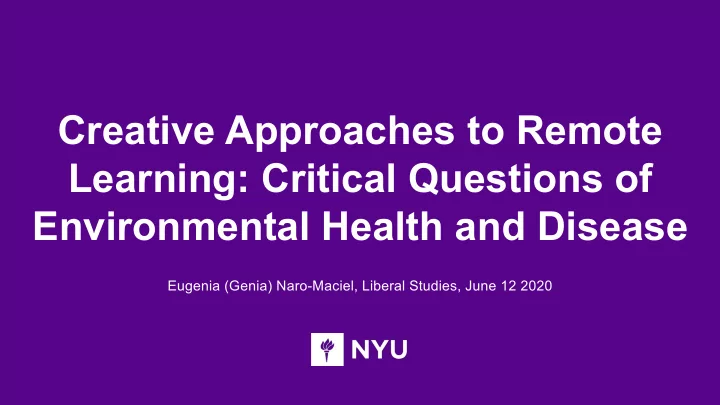

Creative Approaches to Remote Learning: Critical Questions of Environmental Health and Disease Eugenia (Genia) Naro-Maciel, Liberal Studies, June 12 2020
Overview • What is Environmental Health? • COVID-19 as a Teachable Moment • Remote Learning Activity: Critical Questions of Environmental Health and Disease
What is Environmental Health? • Main focus: effects of living and nonliving elements on human health • Other critical questions: • How do humans affect wildlife health? • How do human and wildlife systems interact with regard to health? 3
COVID-19 as a Teachable Moment • Vital teachable moments and opportunities to engage students in this crisis are arising from humanity’s expansion into wild environments containing myriad pathogens, and the export of organisms from these areas through consumption and the wildlife trade. • The SARS-CoV-2 virus is similar to viruses found in bats , and the leading hypothesis is that the pathogen jumped to humans around Wuhan, China, where the outbreak began. 4
COVID-19 as a Teachable Moment • However, several misconceptions have arisen, including various conspiracy theories, such as that the virus was created in a lab for nefarious purposes, respected public health officials or entrepreneurs are doing very bad things, and that bats are to blame and should, therefore, be exterminated. • The global focus on this issue offers opportunities to address these misconceptions , and expand the purview of environmental health to more holistically include wildlife . 5
Remote Learning Activity Critical Questions in Environmental Health and Disease • Active Learning • Fully Online Activity • Students choose among various case studies focused not only on environmental effects on humans, but also on human effects on the environment, as well as broader systems-level interactions. • Current events, individual strategies, and small groupwork are focused on because they are known to captivate students. 6
Remote Learning Activity • Background readings are assigned before the activity and listed on the syllabus. • During a synchronous online class meeting conducted on a platform such as Zoom, background is provided in a short lecture , the activity is outlined , and students choose their breakout groups (3-4 students per group), which may align with shared time zones or interests. • Multiple class meetings may be offered to accommodate different time zones and other factors. • All meetings are recorded , so students unable to attend or wanting to review can watch later. 7
Remote Learning Activity • Students then conduct research on their own before meeting online with their groups asynchronously to discuss their findings and put together a 10-minute presentation using a shared platform such as Google Slides or Google Docs. • This presentation must include class readings and at least three additional scholarly sources as well as the news . Students can annotate their sources using tools like Hypothes.is or Google Docs. • Each presentation must address misconceptions , explain the significance of the case study, cover threats and strategies - including individual actions - to combat these threats, and pose questions for student-guided discussion . 8
Remote Learning Activity • Finally, in a synchronous Zoom session , students present to the rest of the class and guide a ten-minute discussion based on the questions they have brainstormed. • Assessment is carried out by the instructor using a rubric shared with students beforehand , and student peer-reviewers , whose evaluations will also be graded. • Finally, in a round-robin class (or section) -wide discussion guided by the instructor, each student will consider how these cases relate to each other in a systems approach . • This activity can be used in environmental studies, biology, public health , and other related courses, and the framework can be adapted by choosing a different topic, or adjusting parameters such as time spent, for broader use. 9
Thank you! I’ll leave you with two inspiring quotes. “The central idea is to view the entire planet as an ecosystem, to see Earth as it is and not as we wish it to be” (p. 193) ‘… “Despite all of our pretenses and fantasies, we always have been and will remain a biological species tied to this particular biological world ” (p. 211) ― E. O. Wilson [1] “ Only if we understand, can we care . Only if we care, we will help. Only if we help, we shall be saved.”… “ Every individual matters . Every individual has a role to play. Every individual makes a difference.” ― Jane Goodall [2]
Recommend
More recommend